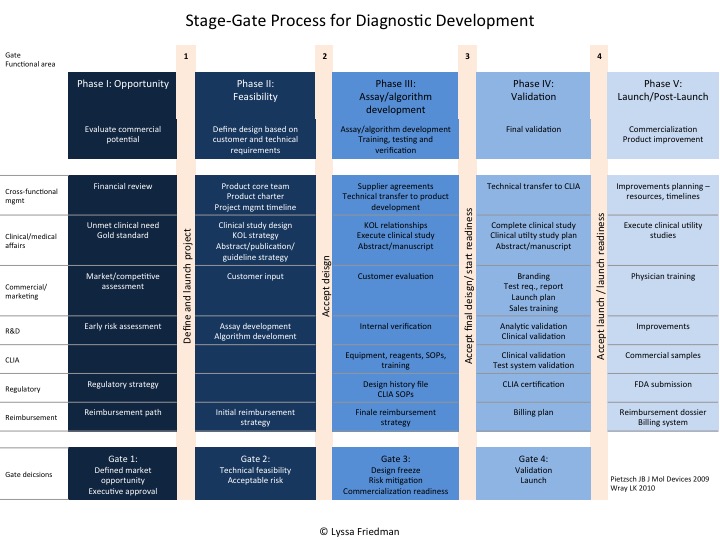A new diagnostic test starts with a hypothesis: we’ve identified an underserved clinical problem, and our solution presents a market opportunity. Success depends on a systematic, step-wise approach from hypothesis to market. At 30,000 feet, we can describe these phases as:
Step 1: Defending the Idea
Step 2: Training and Testing
Step 3: Locking and Testing
Step 4: Launch and Beyond
Let’s start with Step 1: Defending the Idea. Throughout Step 1, we keep a cross-functional eye on the prize: proof of feasibility. This phase has two possible outcomes: go forward or stop early. Getting to the best decision takes work in four crucial Domains: Technical, Clinical, Regulatory and Business. While each Domain addresses unique questions, they overlap and share intelligence. A strong company supports focused work in content-oriented silos while demanding that those silos lack walls. Continuous transparent cross-functional communication sets the process up for a data-driven decision at the phase’s terminus.
THE TECHNICAL DOMAIN: DEVELOPING THE ASSAY AND THE ALGORITHM
This is the phase of creative discovery: of the biomarkers that will distinguish the product from its predecessors, of the assay and algorithmic methods that will shape its intellectual property. We can build this intellectual wealth from scratch or out-license with academic or corporate collaborators.
The assay is under construction. Algorithm development is early and rudimentary. Sample cohorts may be imperfect: heterogeneous, missing deep clinical annotation, collected and handled differently from how a commercial product is envisioned – in short, not quite the end target population.
Learning is iterative. We run a cohort of samples, review the data, learn from the results, and apply that learning to the next cohort. We address these challenges: How will we isolate genomic information? How distinct is the class separation between disease-positive and –negative results? How robust are the samples? We also start to narrow product and test performance requirements. Will this be a high sensitivity or high specificity test? A rule in or rule out test? A discrete result or a continuous variable? A diagnostic, prognostic or predictive application?
Answers to these questions support the feasibility case in the Technical Domain, and lessons learned will build on this foundation during future phase work.
THE CLINICAL DOMAIN: DEFINING THE CLINICAL QUESTION
Concurrent to the scientific learning is our acquisition of clinical fluency. We study the literature, internalize the clinical guidelines, and travel to wherever the authors and experts are, asking questions that pinpoint the clinical problem. How is the condition diagnosed and managed now? How effectively does the standard of care perform? What are the gaps according to academic experts? Physicians in the community? Patient advocacy groups? Patients? How much better does our test need to be, or how does it need to differ from the current norm, to convince physicians to order it?
We also examine the condition’s flow through the healthcare system. What is the referral pattern? Which specialties touch it? Who will order our test and interpret its results? Cognizant that physician reimbursement drives patient visit duration and number per day, how will our sample collection and handling requirements interrupt clinic flow? Given that current referral patterns are relationship-based and highly localized, will our test impact those referral relationships?
Knowledge gained here not only builds the feasibility case in the Clinical Domain; it contributes to market intelligence in the Business Domain. This work will drive study design, define the intended use population, identify the gold standard, initiate collaborator and KOL relationships, and provide early insight into how the publication plan, clinical utility argument and reimbursement strategy will evolve.
THE REGULATORY DOMAIN: IDENTIFYING THE OPTIMAL PATH
At the time of this publication, laboratory developed tests (LDTs), which are developed and manufactured for use in a single lab, are regulated by CMS through CLIA, while the FDA oversees diagnostics manufactured for distribution to other labs. This makes the regulatory path a strategic decision. While a highly complex and expensive test in a specialty market may be well suited to the LDT approach, tests with lower complexity, broader markets, or developed as companion diagnostics fit the FDA-approved in vitro diagnostic (IVD) model. Once the path is defined, these questions bear discussion: What are the time and resource needs? Which quality and documentation system? What pre- and post-market studies? If we intend to expand internationally, do our studies and quality system support outside-US submissions? For the IVD path, how will the device be classified? When and how often do we engage the FDA? For an LDT, do we plan for a future FDA submission? How does that impact our study design and quality system?
Although decisions here should be driven by the business needs, this work helps to define the operational structure for future phases.
THE BUSINESS DOMAIN: MEASURING THE MARKET AND TIME TO REVENUE
While the Business Domain has distinct features, business questions underlie work done in all other Domains and the work done in other Domains contributes to the business case.
Here we define the market, model revenues over time, outline our commercialization strategy and address these questions: What is the competitive environment? Who are our target customers? How will we detail them? How will we address challenges to uptake? What is our brand look and feel? What data will customers need? What evidence will payers require?
Answering these questions solidifies the commercial argument and sets the framework for financial planning and fundraising.
COMPLETING STEP 1: FEASIBILITY
As we complete this phase, we weave together the interconnected lessons learned from each Domain. No product will perform with equal strength in all Domains, but the data collected enables honest risk assessment and clear-eyed decision-making. If we make a data-driven decision to terminate the product, our position will be stronger as we reallocate resources in another direction. If we deicide the opportunity has merit for continuation, the next Step, Training and Testing, is well positioned to begin.

